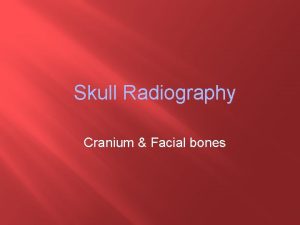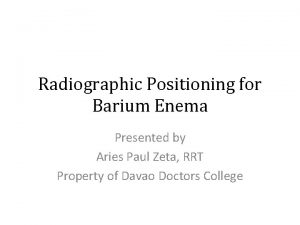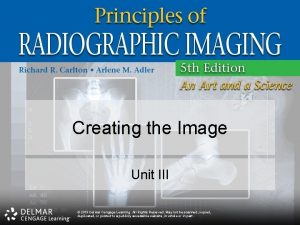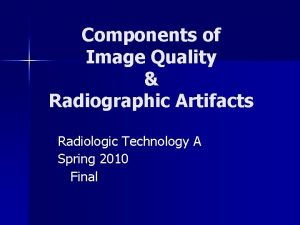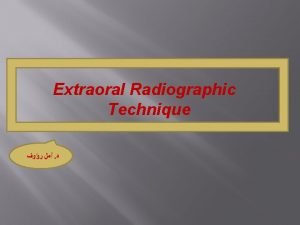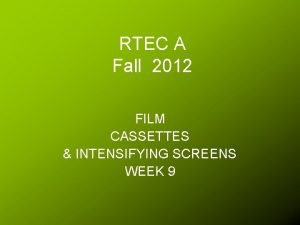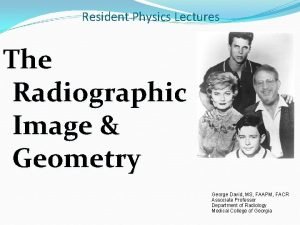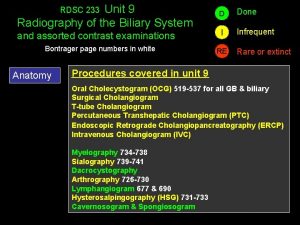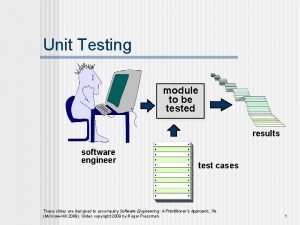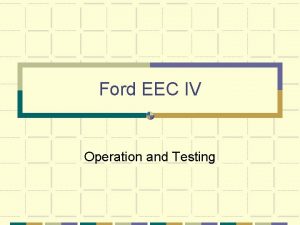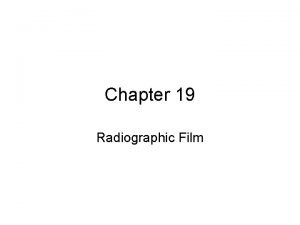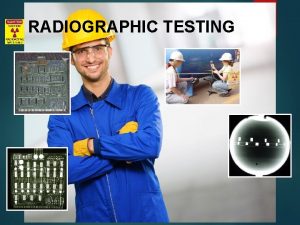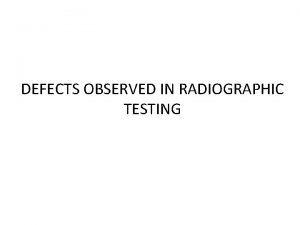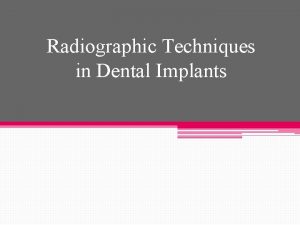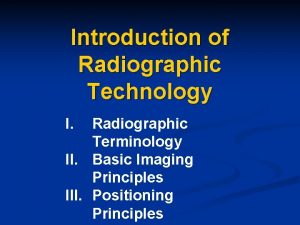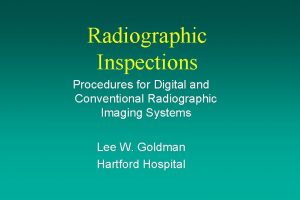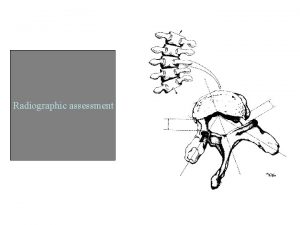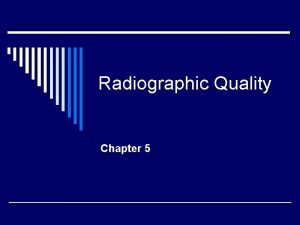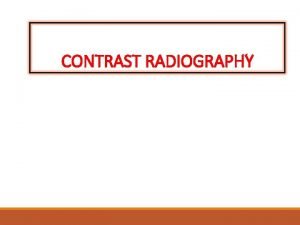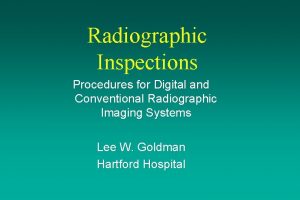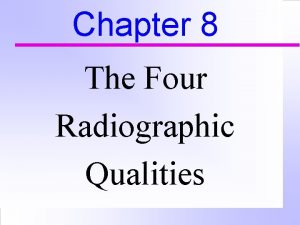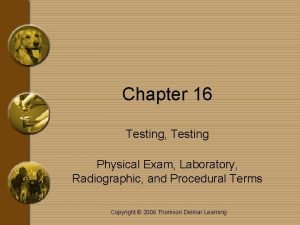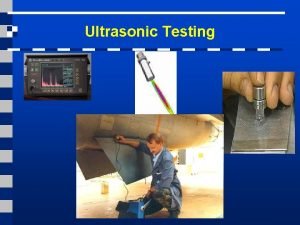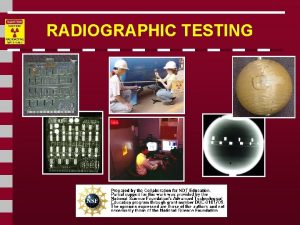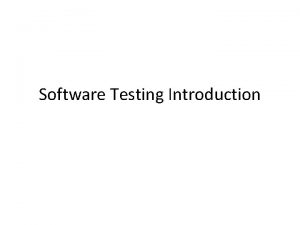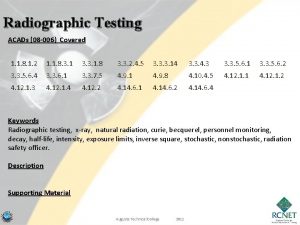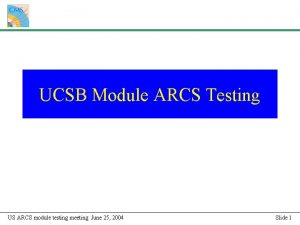RADIOGRAPHIC TESTING Introduction This module presents information on


























































- Slides: 58

RADIOGRAPHIC TESTING

Introduction • This module presents information on the • • • NDT method of radiographic inspection or radiography. Radiography uses penetrating radiation that is directed towards a component. The component stops some of the radiation. The amount that is stopped or absorbed is affected by material density and thickness differences. These differences in “absorption” can be recorded on film, or electronically.

Outline • Electromagnetic Radiation • General Principles of Radiography • Sources of Radiation – Gamma Radiography – X-ray Radiography • Imaging Modalities – Film Radiography – Computed Radiography – Real-Time Radiography – Direct Digital Radiography – Computed Radiography • Radiation Safety • Advantages and Limitations • Glossary of Terms

Electromagnetic Radiation The radiation used in Radiography testing is a higher energy (shorter wavelength) version of the electromagnetic waves that we see every day. Visible light is in the same family as x-rays and gamma rays.

General Principles of Radiography The part is placed between the radiation source and a piece of film. The part will stop some of the radiation. Thicker and more dense area will stop more of the radiation. X-ray film The film darkness (density) will vary with the amount of radiation reaching the film through the test object. = less exposure = more exposure Top view of developed film

General Principles of Radiography • • The energy of the radiation affects its penetrating power. Higher energy radiation can penetrate thicker and more dense materials. The radiation energy and/or exposure time must be controlled to properly image the region of interest. Thin Walled Area Low Energy Radiation High energy Radiation

IDL 2001 Flaw Orientation Radiography has sensitivity limitations when detecting cracks. Optimum Angle = easy to detect = not easy to detect X-rays “see” a crack as a thickness variation and the larger the variation, the easier the crack is to detect. When the path of the x-rays is not parallel to a crack, the thickness variation is less and the crack may not be visible.

IDL 2001 Flaw Orientation (cont. ) Since the angle between the radiation beam and a crack or other linear defect is so critical, the orientation of defect must be well known if radiography is going to be used to perform the inspection. 0 o 10 o 20 o

Radiation Sources Two of the most commonly used sources of radiation in industrial radiography are x-ray generators and gamma ray sources. Industrial radiography is often subdivided into “X-ray Radiography” or “Gamma Radiography”, depending on the source of radiation used.

Gamma Radiography • Gamma rays are produced by a radioisotope. • A radioisotope has an unstable nuclei that does not have enough binding energy to hold the nucleus together. • The spontaneous breakdown of an atomic nucleus resulting in the release of energy and matter is known as radioactive decay.

Gamma Radiography (cont. ) • Most of the radioactive material used in industrial radiography is artificially produced. • This is done by subjecting stable material to a source of neutrons in a special nuclear reactor. • This process is called activation.

Gamma Radiography (cont. ) Unlike X-rays, which are produced by a machine, gamma rays cannot be turned off. Radioisotopes used for gamma radiography are encapsulated to prevent leakage of the material. The radioactive “capsule” is attached to a cable to form what is often called a “pigtail. ” The pigtail has a special connector at the other end that attaches to a drive cable.

Gamma Radiography (cont. ) A device called a “camera” is used to store, transport and expose the pigtail containing the radioactive material. The camera contains shielding material which reduces the radiographer’s exposure to radiation during use.

Gamma Radiography (cont. ) A hose-like device called a guide tube is connected to a threaded hole called an “exit port” in the camera. The radioactive material will leave and return to the camera through this opening when performing an exposure!

Gamma Radiography (cont. ) A “drive cable” is connected to the other end of the camera. This cable, controlled by the radiographer, is used to force the radioactive material out into the guide tube where the gamma rays will pass through the specimen and expose the recording device.

X-ray Radiography Unlike gamma rays, x-rays are produced by an X-ray generator system. These systems typically include an X-ray tube head, a high voltage generator, and a control console.

X-ray Radiography (cont. ) • X-rays are produced by establishing a very high voltage between two electrodes, called the anode and cathode. • To prevent arcing, the anode and cathode are located inside a vacuum tube, which is protected by a metal housing.

X-ray Radiography (cont. ) • The cathode contains a small filament much the same as in a light bulb. • Current is passed through the filament which heats it. The heat causes electrons to be stripped off. • The high voltage causes these “free” electrons to be pulled toward a target material (usually made of tungsten) located in the anode. • The electrons impact against the target. This impact causes an energy exchange which causes x-rays to be created. High Electrical Potential Electrons + - X-ray Generator or Radioactive Source Creates Radiation Penetrate the Sample Exposure Recording Device

Imaging Modalities Several different imaging methods are available to display the final image in industrial radiography: • Film Radiography • Real Time Radiography • Computed Tomography (CT) • Digital Radiography (DR) • Computed Radiography (CR)

Film Radiography • One of the most widely used and oldest imaging mediums in industrial radiography is radiographic film. • Film contains microscopic material called silver bromide. • Once exposed to radiation and developed in a darkroom, silver bromide turns to black metallic silver which forms the image.

Film Radiography (cont. ) • • Film must be protected from visible light. Light, just like x-rays and gamma rays, can expose film. Film is loaded in a “light proof” cassette in a darkroom. This cassette is then placed on the specimen opposite the source of radiation. Film is often placed between screens to intensify radiation.

Film Radiography (cont. ) • • In order for the image to be viewed, the film must be “developed” in a darkroom. The process is very similar to photographic film development. Film processing can either be performed manually in open tanks or in an automatic processor.

Film Radiography (cont. ) Once developed, the film is typically referred to as a “radiograph. ”

Digital Radiography • One of the newest forms of radiographic • • • imaging is “Digital Radiography”. Requiring no film, digital radiographic images are captured using either special phosphor screens or flat panels containing micro-electronic sensors. No darkrooms are needed to process film, and captured images can be digitally enhanced for increased detail. Images are also easily archived (stored) when in digital form.

Digital Radiography (cont. ) There a number of forms of digital radiographic imaging including: • Computed Radiography (CR) • Real-time Radiography (RTR) • Direct Radiographic Imaging (DR) • Computed Tomography

Computed Radiography (CR) is a digital imaging process that uses a special imaging plate which employs storage phosphors.

Computed Radiography (cont. ) X-rays penetrating the specimen stimulate the phosphors. The stimulated phosphors remain in an excited state. CR Phosphor Screen Structure X-Rays Protective Layer Phosphor Grains Substrate

Computed Radiography (cont. ) After exposure: The imaging plate is read electronically and erased for reuse in a special scanner system.

Computed Radiography (cont. ) As a laser scans the imaging plate, light is emitted where X-rays stimulated the phosphor during exposure. The light is then converted to a digital value. Optical Scanner Photo-multiplier Tube Laser Beam A/D Converter Imaging Plate 110010010010110 Motor

Computed Radiography (cont. ) Digital images are typically sent to a computer workstation where specialized software allows manipulation and enhancement.

Computed Radiography (cont. ) Examples of computed radiographs:

Real-Time Radiography • • • Real-Time Radiography (RTR) is a term used to describe a form of radiography that allows electronic images to be captured and viewed in real time. Because image acquisition is almost instantaneous, X-ray images can be viewed as the part is moved and rotated. Manipulating the part can be advantageous for several reasons: – It may be possible to image the entire component with one exposure. – Viewing the internal structure of the part from different angular prospectives can provide additional data for analysis. – Time of inspection can often be reduced.

Real-Time Radiography (cont. ) n The equipment needed for an RTR • Computer with frame includes: grabber board and • X-ray tube software • Image intensifier or other real-time detector • Monitor • Sample positioning • Camera system (optional)

Real-Time Radiography (cont. ) • The image intensifier is a device that converts the radiation that passes through the specimen into light. • It uses materials that fluoresce when struck by radiation. • The more radiation that reaches the input screen, the more light that is given off. • The image is very faint on the input screen so it is intensified onto a small screen inside the intensifier where the image is viewed with a camera.

Real-Time Radiography (cont. ) • A special camera which captures the light output of the screen is located near the image intensifying screen. • The camera is very sensitive to a variety of different light intensities. • • A monitor is then connected to the camera to provide a viewable image. If a sample positioning system is employed, the part can be moved around and rotated to image different internal features of the part.

Real-Time Radiography (cont. ) Comparing Film and Real-Time Radiography Real-time images are lighter in areas where more X-ray photons reach and excite the fluorescent screen. Film images are darker in areas where more X-ray photons reach and ionize the silver molecules in the film.

Direct Radiography • Direct radiography (DR) is a form of real-time radiography that uses a special flat panel detector. • The panel works by converting penetrating radiation passing through the test specimen into minute electrical charges. • The panel contains many microelectronic capacitors. The capacitors form an electrical charge pattern image of the specimen. • Each capacitor’s charge is converted into a pixel which forms the digital image.

Computed Tomography (CT) uses a real-time inspection system employing a sample positioning system and special software.

Computed Tomography (cont. ) • • Many separate images are saved (grabbed) and complied into 2 -dimensional sections as the sample is rotated. 2 -D images are them combined into 3 -dimensional images. Real-Time Captures Compiled 2 -D Images Compiled 3 -D Structure

Image Quality • • • Image quality is critical for accurate assessment of a test specimen’s integrity. Various tools called Image Quality Indicators (IQIs) are used for this purpose. There are many different designs of IQIs. Some contain artificial holes of varying size drilled in metal plaques while others are manufactured from wires of differing diameters mounted next to one another.

Image Quality (cont. ) • • IQIs are typically placed on or next to a test specimen. Quality typically being determined based on the smallest hole or wire diameter that is reproduced on the image.

Radiation Safety Use of radiation sources in industrial radiography is heavily regulated by state and federal organizations due to potential public and personal risks.

Radiation Safety (cont. ) There are many sources of radiation. In general, a person receives roughly 100 mrem/year from natural sources and roughly 100 mrem/year from manmade sources.

Radiation Safety (cont. ) X-rays and gamma rays are forms of ionizing radiation, which means that they have the ability to form ions in the material that is penetrated. All living organisms are sensitive to the effects of ionizing radiation (radiation burns, x-ray food pasteurization, etc. ) X-rays and gamma rays have enough energy to liberate electrons from atoms and damage the molecular structure of cells. This can cause radiation burns or cancer.

Radiation Safety (cont. ) Technicians who work with radiation must wear monitoring devices that keep track of their total absorption, and alert them when they are in a high radiation area. Survey Meter Pocket Dosimeter Radiation Alarm Radiation Badge

Radiation Safety (cont. ) There are three means of protection to help reduce exposure to radiation:

Radiographic Images

Radiographic Images Can you determine what object was radiographed in this and the next three slides?

Radiographic Images

Radiographic Images

Radiographic Images

Advantages of Radiography • Technique is not limited by material type or density. • Can inspect assembled components. • Minimum surface preparation required. • Sensitive to changes in thickness, • • corrosion, voids, cracks, and material density changes. Detects both surface and subsurface defects. Provides a permanent record of the inspection.

Disadvantages of Radiography • Many safety precautions for the use of • • • high intensity radiation. Many hours of technician training prior to use. Access to both sides of sample required. Orientation of equipment and flaw can be critical. Determining flaw depth is impossible without additional angled exposures. Expensive initial equipment cost.

Glossary of Terms • Activation: the process of creating • • radioactive material from stable material usually by bombarding a stable material with a large number of free neutrons. This process typically takes place in a special nuclear reactor. Anode: a positively charged electrode. Automatic Film Processor: a machine designed to develop film with very little human intervention. Automatic processors are very fast compared to manual development.

Glossary of Terms • Capacitor: an electrical device that stores an • • electrical charge which can be released on demand. Cathode: a negatively charged electrode. Darkroom: a darkened room for the purpose of film development. Film is very sensitive to exposure by visible light and may be ruined. Exposure: the process of radiation penetrating and object. Gamma Rays: electromagnetic radiation emitted from the nucleus of a some radioactive materials.

Glossary of Terms • Phosphor: a chemical substance that emits • • light when excited by radiation. Pixel: Short for Picture Element, a pixel is a single point in a graphic image. Graphics monitors display pictures by dividing the display screen into thousands (or millions) of pixels, arranged in rows and columns. The pixels are so close together that they appear connected. Photo-multiplier tube: an amplifier used to convert light into electrical signals.

Glossary of Terms • Radioactive: to give off radiation • • spontaneously. Radiograph: an image of the internal structure of and object produced using a source of radiation and a recording device. Silver Bromide: silver and bromine compound used in film emulsion to form the image seen on a radiograph.

For More Information The Collaboration for NDT Education www. ndt-ed. org The American Society for Nondestructive Testing www. asnt. org
 Mandible x ray positioning towne's
Mandible x ray positioning towne's Hampton view positioning
Hampton view positioning Off center grid
Off center grid What are the two areas in dark room? *
What are the two areas in dark room? * Dental radiology ppt
Dental radiology ppt Radiographic base line
Radiographic base line Warped cassette
Warped cassette Periodontal ligament space radiograph
Periodontal ligament space radiograph Radiographic film
Radiographic film Guide shoe mark artifact
Guide shoe mark artifact Extraoral radiographic techniques
Extraoral radiographic techniques Radiographic films
Radiographic films Geometric penumbra formula
Geometric penumbra formula Ercp images
Ercp images C device module module 1
C device module module 1 Module testing in software engineering
Module testing in software engineering Eec test ford
Eec test ford Keywords for cause and effect text structure
Keywords for cause and effect text structure Presents from my aunts in pakistan poem
Presents from my aunts in pakistan poem Pear paragraph example
Pear paragraph example Sally elatta presents on business agility
Sally elatta presents on business agility 16 3 darwin presents his case answer key
16 3 darwin presents his case answer key Section 15-3 darwin presents his case answer key
Section 15-3 darwin presents his case answer key Sats booster maths
Sats booster maths Sue palmer skeleton books
Sue palmer skeleton books Zids and zods answers
Zids and zods answers Prose writing that presents and explains ideas
Prose writing that presents and explains ideas What is nonfiction prose
What is nonfiction prose Zids and zods
Zids and zods Where does “snowflake girl” help to deliver presents?
Where does “snowflake girl” help to deliver presents? Mot de bienvenue au culte d'adoration
Mot de bienvenue au culte d'adoration Thesis statement and main idea
Thesis statement and main idea A 26 year old female presents
A 26 year old female presents This presents
This presents What is a tragedy
What is a tragedy What are the four narrative essentials of a play
What are the four narrative essentials of a play The text presents
The text presents Shcedules
Shcedules What are the elements of tragedy in macbeth
What are the elements of tragedy in macbeth Which option presents a clear point of view
Which option presents a clear point of view A thesis statement presents
A thesis statement presents Which sentence presents a faulty either/or argument?
Which sentence presents a faulty either/or argument? A 41 year old man presents with slow irregular breathing
A 41 year old man presents with slow irregular breathing What is domain
What is domain Kv charts in software testing
Kv charts in software testing Data flow testing strategies in software testing
Data flow testing strategies in software testing Positive testing vs negative testing
Positive testing vs negative testing Cs 3250
Cs 3250 What is globalization testing
What is globalization testing Neighborhood integration testing
Neighborhood integration testing Language testing
Language testing Control structure testing in software engineering
Control structure testing in software engineering Decision table testing in software testing
Decision table testing in software testing Decision table based testing
Decision table based testing Apa yang dimaksud dengan black box testing
Apa yang dimaksud dengan black box testing Black-box testing disebut juga sebagai behavioral testing
Black-box testing disebut juga sebagai behavioral testing Decision table testing
Decision table testing Rigorous testing in software testing
Rigorous testing in software testing Testing blindness in software testing
Testing blindness in software testing
